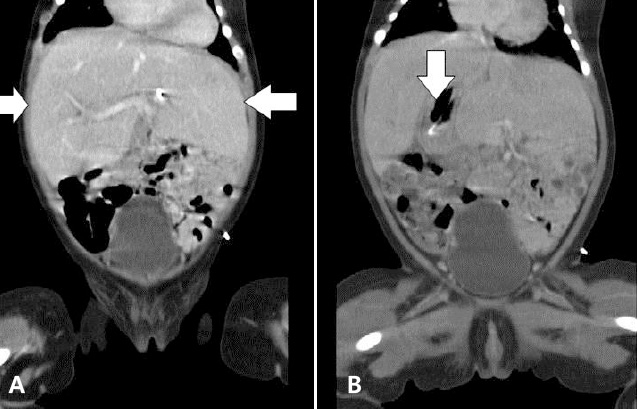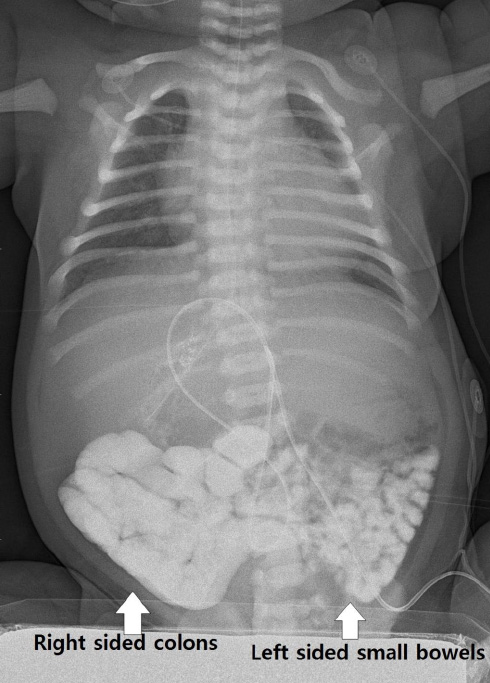Perinatology.
2018 Mar;29(1):52-56. 10.14734/PN.2018.29.1.52.
Situs Ambiguous with Polysplenia of Macrosomia
- Affiliations
-
- 1Department of Pediatrics, Nowon Eulji Medical Center, Eulji University, Seoul, Korea. yhs3211@eulji.ac.kr
- KMID: 2409113
- DOI: http://doi.org/10.14734/PN.2018.29.1.52
Abstract
- Situs ambiguous is a very rare disease with one or less per 10,000 newborns whose organs are not in normal position. It usually has spleen and heart malformations, and if it is accompanied by cardiac malformations, mortality is high. Intestinal malrotation is also seen in 70% of the newborn with situs ambiguous and active treatment is needed when intestinal malrotation are found. We report one case of situs ambiguous with polysplenia in macrosomia in a diabetic mother.
MeSH Terms
Figure
Reference
-
1. Jacobs JP, Anderson RH, Weinberg PM, Walters HL 3rd, Tchervenkov CI, Del Duca D, et al. The nomenclature, definition and classification of cardiac structures in the setting of heterotaxy. Cardiol Young. 2007; 17:Suppl 2. 1–28.
Article2. Lin AE, Ticho BS, Houde K, Westgate MN, Holmes LB. Heterotaxy: associated conditions and hospital-based prevalence in newborns. Genet Med. 2000; 2:157–172.
Article3. Escobar-Diaz MC, Friedman K, Salem Y, Marx GR, Kalish BT, Lafranchi T, et al. Perinatal and infant outcomes of prenatal diagnosis of heterotaxy syndrome (asplenia and polysplenia). Am J Cardiol. 2014; 114:612–617.
Article4. Boyd ME, Usher RH, Mclean FH. Fetal macrosomia: prediction, risks, proposed management. Obstet Gynecol. 1983; 61:715–722.5. Kim JS, Chi KS, Jang EJ, Hwang JY. A case of pregnancy complicated by situs inversus totalis fetus in overt diabetic women. Korean J Perinatol. 2007; 18:271–276.6. Morishima M, Ando M, Takao A. Visceroatrial heterotaxy syndrome in the NOD mouse with special reference to atrial situs. Teratology. 1991; 44:91–100.
Article7. Paladini D, Volpe P. Ultrasound of congenital fetal anomalies: differential diagnosis and prognostic indicators. 2th ed. Boca Raton: CRC Press;2014.8. Rose V, Izukawa T, Moës CA. Syndromes of asplenia and polysplenia. A review of cardiac and non-cardiac malformations in 60 cases withspecial reference to diagnosis and prognosis. Br Heart J. 1975; 37:840–852.
Article9. Gatrad AR, Read AP, Watson GH. Consanguinity and complex cardiac anomalies with situs ambiguus. Arch Dis Child. 1984; 59:242–245.
Article10. Applegate KE, Goske MJ, Pierce G, Murphy D. Situs revisited: imaging of the heterotaxy syndrome. Radiographics. 1999; 19:837–852.
Article11. Christine AG, Sherin UD. Avery's disease of the newborn. 9th ed. Philadelphia: Elsevier;2012. p. 51–91.12. Yoo SJ, Jaeggi E. Ultrasound evaluation of the fetal heart. ultrasonography in obstetetrics and gynecology. 5th ed. Philadelphia: Saunders Elsevier;2008. p. 523–528.13. Mahalik SK, Khanna S, Menon P. Malrotation and volvulus associated with heterotaxy syndrome. J Indian Assoc Pediatr Surg. 2012; 17:138–140.
Article14. Mujo T, Finnegan T, Joshi J, Wilcoxen KA, Reed JC. Situs ambiguous, levocardia, right sided stomach, obstructing duodenal web, and intestinal nonrotation: a case report. J Radiol Case Rep. 2015; 9:16–23.
Article15. Choi M, Borenstein SH, Hornberger L, Langer JC. Heterotaxia syndrome: the role of screening for intestinal rotation abnormalities. Arch Dis Child. 2005; 90:813–815.
Article
- Full Text Links
- Actions
-
Cited
- CITED
-
- Close
- Share
- Similar articles
-
- A Case of Noncompaction of the Ventricular Myocardium Combined with Situs Ambiguous with Polysplenia
- Incidentally Detected Situs Ambiguous in Adults
- Situs Inversus Totalis, Polysplenia and Annular Pancreas with Duodenal Obstruction: a Case Report of Bizarre Embryological Conundrum
- Anomalies of Abdominal Organs in Polysplenia Syndrome: Multidetector Computed Tomography Findings
- Neonatal Duodenal Obstruction Associated with Situs Inversus Totalis: A Case Report




